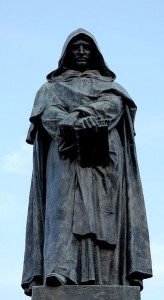Today marks the anniversary of the death of the Italian Renaissance philosopher Giordano Bruno. Most of us associate the initiation of modern cosmology with Nicolaus Copernicus (the first to convincingly place the Sun instead of the Earth at the centre of things) and Galileo Galilei (whose ground-breaking astronomical work put the Copernican perspective on solid footing). Bruno, a contemporary of Galileo, is less well-recognized, but for many reasons deserves our close attention. He contributed less to the important mathematical and astronomical underpinnings of modern science, but his powerful imagination and heretical religious sensibilities, blossoming at this crucial juncture when science and religion began their bitter divorce proceedings, have much to teach us.
Born in 1548 in Nola, near Naples, at the age of 17 Bruno became a Dominican friar, and early on developed a fascination with mnemonic techniques and controversial theology. When suspicions at the monastery got too much, he fled. For the next 16 years – the rest of his free life – he wandered Italy and Europe, occasionally attempting a return to the Catholic fold, and impressing the rich and powerful with his prodigious feats of memory. He visited France, Switzerland, England and Germany, associating with figures such as King Henry III of France and Sir Philip Sydney.
Living, of course, in the thick of the religious and political tensions of the Protestant Reformation, Bruno’s traversal of the geographical fault lines of this divide found him directly confronting the realities of his time. More than once he fled cities in the wake of religious violence; frequently he was ousted by ecclesiastical authorities, both Protestant and Catholic. Mistakenly believing himself safe in Italy, he returned there in 1591. Denounced by a disgruntled patron, he was arrested by the Venetian Inquisition, then imprisoned in Rome for the next 7 years during his protracted trial for blasphemy and heresy.
What was Bruno charged with? Due to lost records, we do not know exactly. Of course, his support for Copernicus was a factor (though probably not an important one). Persistent rumours of sorcery certainly did him no favours. But most important were his wider cosmological notions, and the theology that underpinned them. Copernicus, though radical in proposing the Sun as the centre of the universe, still held to the idea that the universe was finite, delimited by the fixed ‘sphere of the stars’. Following Nicholas of Cusa, Bruno believed that because God is infinite, it must follow that his creation is infinite, too. Further, Bruno was the first to posit the idea that the infinite stars were in fact suns like our own, orbited by planets like our own (SETI have a Giordano Bruno memorial award).
Bruno was more a visionary than an astronomer, though. Heavily influenced by Hermetic and Neoplatonist ideas, for him the Copernican model was as much a hieroglyph as a description, a sacred emblem of the structure of the infinite solar systems we see strewn across the night sky. His belief that the Earth moved was fuelled by his belief that the planet, “our perpetual nurse and mother”, was alive. Indeed, he believed God to be immanent throughout His creation, not cut off in some remote heaven.
Bruno’s memory techniques were closely intertwined with this almost animistic sensibility. The various phenomena of the world were embedded in the mind via an all-embracing system of categorization, built on the planets and the zodiac, and visualized in a kind of internal architecture. Ultimately, this art was less a practical tool or some kind of trick to impress – it was Bruno’s way of navigating the universe’s infinity, of bringing it into himself, of awakening to the inherent links between ourselves and the divine world. Unlike Copernicus, he rejected mathematics as a basis for understanding the infinite cosmos, believing its abstractions to be insufficient to grapple with the complexities of experienced reality. Although Bruno’s art of memory heralds in some ways the scientific projects of classification, it was actually an attempt to embrace the material reality of the modern cosmos without discarding the archaic sense of the world as a living system of connections. Bruno was celebrated by humanists during the 19th century as a martyr to modern science; but his real significance is as someone who fiercely resisted the rigid split between psyche and cosmos that has left us all so deeply alienated.
For this effort, Bruno was burned at the stake in 1600 in a Roman market square.
While in Folsom Prison in the early 1970s, Timothy Leary (who of course identified with Bruno as a persecuted gnostic scientist) wrote in praise of his wife Joanna, and spoke of the “super-nova” energy she radiated in the visiting room. “She was asking people she met: what’s your cosmology? Never mind your sexual need, your bread problem, your ideas on Watergate. What’s your cosmology?” Cosmology is fundamental, the foundations of a culture. And every cosmology is a psychocosmology; it inevitably expresses and embraces the inner world. If your cosmology cuts the psyche out of the picture, leaving it incarcerated inside the skin, or explained away, unexplored and untreasured, your world withers and dies. It will not sustain.
“We must place ourselves, I say, first in the intellectual heaven which is within us, and then in this sensible and corporeal heaven which presents itself to our eyes.” – Giordano Bruno, ‘The Expulsion of the Triumphant Beast’ (1584)
[Written by Gyrus]



4 Responses to 17th February 1600 – the Death of Giordano Bruno